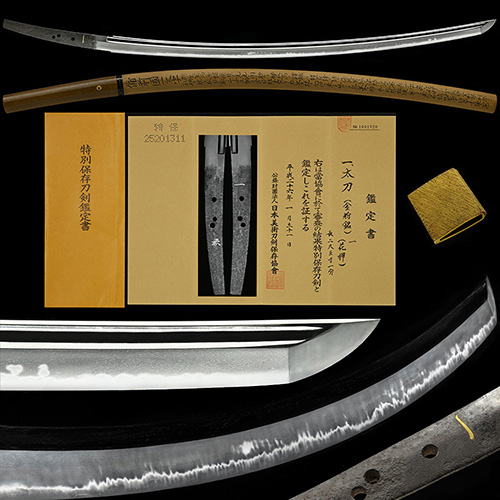
片山一文字 刀 Katayama Ichimonji Katana
No.152678刀 片山一文字 則房 乱れ映りに華やかな丁子乱れ健全傑作刀 金無垢ハバキ時代梨子地塗鞘打刀拵付 二尺二寸六分Katana Katayama Ichimonji Norifusa Midare-Utsuri Gorgeouse-Choji-Midare Kenzen Masterpiece With Solid Gold Habaki Jidai-Nashiji Nurisaya-Uchikatana-Koshirae 68.6cm
ご成約Sold
関連商品
- 極めKiwame
- 片山一文字Katayama Ichimonji
- 登録証Registration
- 宮城県 Miyagi 平成17年7月15日 7/15/17(Heisei)
- 時代Period
- 鎌倉時代Kamakura period
- 法量Size
-
刃長 68.6cm (二尺二寸六分) 反り 1.4cm
元幅 3.0cm 先幅 2.1cm 元重 0.64cm 鎬厚 0.78cm 先重 0.42cm 鋒長 4.9cm 茎長 17.8cm 重量 663gHachou 68.6cm (二尺二寸六分) Sori 1.4cm
Moto-Haba 3.0cm Saki-Haba 2.1cm Moto-Kasane 0.64cm Shinogi-Thikess 0.78cm Saki-Kasane 0.42cm Kissaki-Chou 4.9cm Nakago-Chou 17.8cm Weight 663g - 国Country
- 備前Bizen
- 姿Shape
- 鎬造、庵棟、身幅広く、反り尋常、腰反りつき、中鋒やや延びる。Shinogidukuri, Iorimune, Wide Mihaba, Standard Sori, Koshizori-tsuki, Chu-Kissaki slightly extended.
- 鍛Kitae
- 板目肌つみ、杢目肌交じり、地沸微塵につき、地景細入り、乱れ映り立つ。Itame-hada-tsumi, Mixed Mokume-hada, Jinie entered finely, Chikei sincerely, Midare-Utsuritatsu.
- 刃文Hamon
- 焼き幅大きな丁子乱れに、重花風の丁子・袋丁子など交じえ、足・葉頻りに入り、小沸深く付き、金筋・砂流し掛り、匂口明るい。Big Yakihaba Chouji-Midare, Juka-style Chouji, Mixed Fukuro-Chouji, There are many Ashi and You, Small-Nie entered deeply, Kinsuji and Sunagashi-kakari, Nioikuchi is bright.
- 帽子Boushi
- 表直ぐに小丸、裏乱れ込んで小丸。Suguni-Komaru on the front, Midarekonde-Komaru on the back.
- 茎Nakago
- 大磨上、先切、鑢目筋違、目釘孔一。Oh-suriage, Sakikiri, Yasurimesujikai, Mekugiana is one(1)
- ハバキHabaki
- 金無垢二重Solid gold double.
- 拵Sword mounitings
- 梨子地塗鞘打刀拵 [江戸時代]
法量
長さ98.3cm 反り3.1cm
説明
鐔 赤銅磨地金象嵌、 縁頭 赤銅魚子地菊紋散図金色絵 目貫 金無垢馬図。Nashiji-Nurisaya-Uchikatana-Koshirae(Edo period)
Length:98.3cm
Sori;3.1cm
Tsuba:Syakudou Migakiji Kinzougan
Fuchigashira: Syakudounanakoji Kiku Monchirashi-zu Kiniroe
Menuki: Kinmuku Urazu - 彫物Carving
- 表裏に棒樋を掻き流す。Scrape Bohi on the front and back.
- 説明Drscription
- 則房は、福岡一文字助房の子と伝え、助真・吉房とならんで最も華やかな丁子乱れを焼き、鎌倉時代中期の一文字派を代表する刀工である。則房は、のち福岡より片山に移住して作刀したと伝え、片山一文字と呼称される。作風は、助真・吉房に類する華やかな丁子乱れのものの他に、地沸が微塵について強く冴え、映りの目立たないもの、逆ごころの刃が目立つもの、小模様のものなどがある。この刀は、元は80cmを超える太刀であったと思われ、身幅広く、腰反りつき、鋒やや延びる優美な姿で、乱れ映りが立ち、地沸が微塵につく精良な地鉄に、華やかな丁子乱れに、重花丁子・袋丁子など複雑に交え、逆足・足・葉頻りに入り、小沸深くつき、金筋・砂流し掛り、匂口明い。覇気溢れる華やかな出来で、研ぎ減りも無く、頗る健全な傑作刀である。Norifusa is said to be a child of Fukuoka Ichimonji Sukefusa, and along with Sukezane and Yoshifusa, he burns the most gorgeous clove disorder and is a swordsmith representing the Ichimonji school in the middle of the Kamakura period.Norifusa later moved to Katayama from Fukuoka and reportedly made a sword, and is called Katayama Ichimonji.In the past, it was generally accepted that the place called Katayama was Bicchunokuni, but in recent years, the theory that it may be Katayama near Bizen Fukuoka has emerged and is regarded as promising.In addition to the gorgeous Chouji-midare style similar to Sukezane / Yoshifusa, Jinie has a strong sense of fine dust and Utsuri's inconspicuous style. Some of Gyakugokoro's blades stand out, and some have small patterns.
This sword is thought to have originally been a sword over 80cm long Tachi, and has a graceful appearance with wide Mihaba, Koshizori-tsuki, Kissaki slightly extended. Midare-Utsuritachi, Jinie entered finely good Jigane, Gorgeouse Chouji-Midare, Intricately mixed Fukuro-Chouji and Juka-style Chouji, Sakaashi, There are many Ashi and You, Small-Nie-tsuki, Kinsuji and Sunagashi-kakari, Nioikuchi is bright. It is a masterpiece sword full of ambition, with no sharpening loss, and it is a remarkablyKenzen sound masterpiece sword.




